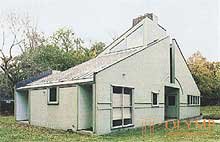
 Direction in architecture and art of developed countries of the 2nd half of the 70s — early 80s. 20 in. There is no single definition of postmodernism.
Direction in architecture and art of developed countries of the 2nd half of the 70s — early 80s. 20 in. There is no single definition of postmodernism. 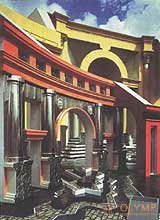 The most acceptable definition of postmodernism as a direction that opposes itself to modernism and pretends to replace it, which distinguishes postmodernism from the existing at the same time "neo-avant-gardism" or "late modernism", consistently developing modernist concepts. With all its anti-militarism, postmodernism is essentially conservative. Postmodernism promotes "realism", i.e., passive subordination to the existing socio-exonomic and cultural order of society.
The most acceptable definition of postmodernism as a direction that opposes itself to modernism and pretends to replace it, which distinguishes postmodernism from the existing at the same time "neo-avant-gardism" or "late modernism", consistently developing modernist concepts. With all its anti-militarism, postmodernism is essentially conservative. Postmodernism promotes "realism", i.e., passive subordination to the existing socio-exonomic and cultural order of society.
Postmodernism practices open retrospectiveness, an eclectic appeal to traditional art forms; comparing them in an unusual way, he creates a kind of theatrical aesthetic environment in which elements of irony and grotesque are often introduced.
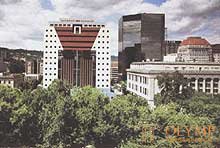 Most vividly postmodernism expressed itself in architecture.
Most vividly postmodernism expressed itself in architecture. 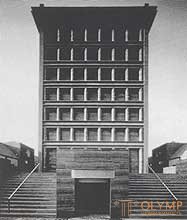 Since the late 70s. public centers were built, surrounded by brightly painted arcades and pillars resembling ancient Roman forums and Roman baroque buildings, in which the old architectural forms were renewed and grotesquely rethought, new, non-traditional materials were introduced: anodized aluminum, stainless steel, neon tubes, etc. (Piazza d'Italia in New Orleans, USA, architect C. Moore); satellite cities, laid out according to a strictly axial system, built up with houses with heavy cornices and gables, powerful decorative columns on rusticated stylobates (new satellite cities of Paris, Spanish architect R. Bofill); wooden and stone mansions with developed pitched roofs and hanging eaves, dormer windows and chimneys (projects of the American architect R. Venturi).
Since the late 70s. public centers were built, surrounded by brightly painted arcades and pillars resembling ancient Roman forums and Roman baroque buildings, in which the old architectural forms were renewed and grotesquely rethought, new, non-traditional materials were introduced: anodized aluminum, stainless steel, neon tubes, etc. (Piazza d'Italia in New Orleans, USA, architect C. Moore); satellite cities, laid out according to a strictly axial system, built up with houses with heavy cornices and gables, powerful decorative columns on rusticated stylobates (new satellite cities of Paris, Spanish architect R. Bofill); wooden and stone mansions with developed pitched roofs and hanging eaves, dormer windows and chimneys (projects of the American architect R. Venturi). 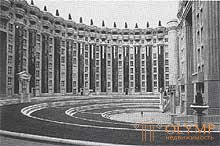 The interiors of these buildings are decorated with bulky old-fashioned furniture, and the facades are decorated with works of hyper-realists, super graphics. In art, postmodernism is usually associated with trends that are subject to natural artistic perception of life.
The interiors of these buildings are decorated with bulky old-fashioned furniture, and the facades are decorated with works of hyper-realists, super graphics. In art, postmodernism is usually associated with trends that are subject to natural artistic perception of life.
Что бы оставить комментарий войдите
Комментарии (0)